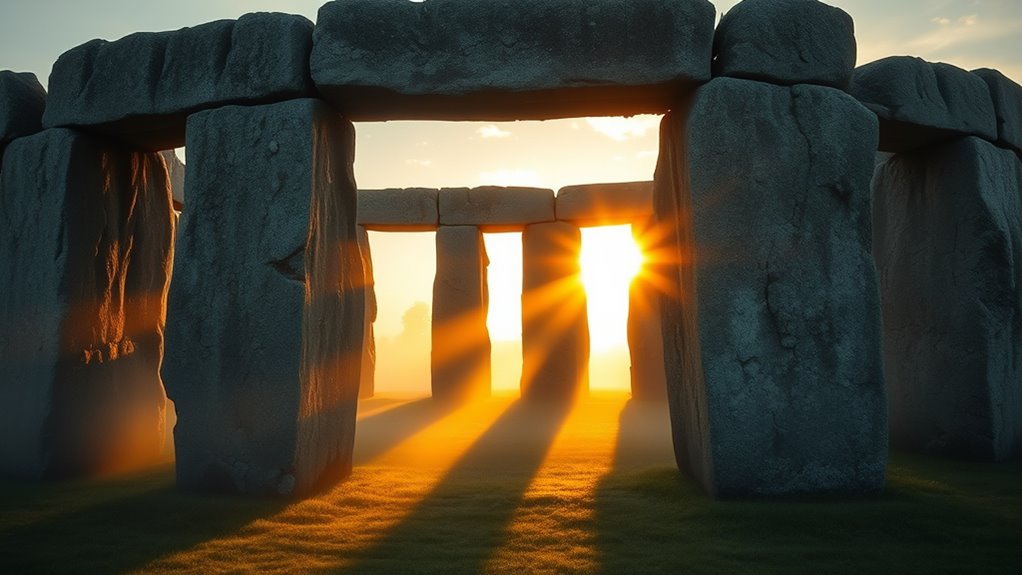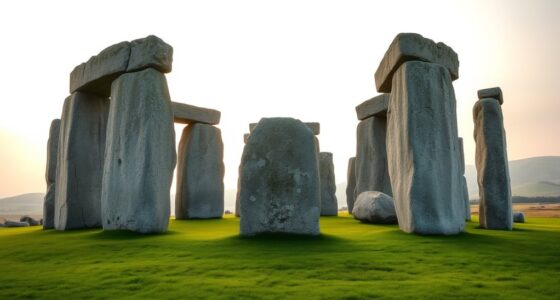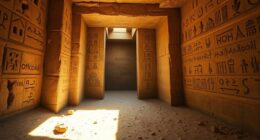Stonehenge’s stones were deliberately arranged to create powerful acoustic effects, shaping ancient rituals. When you stand inside or near the circle, you’ll notice resonant sounds and echoes that seem intentionally designed. These soundscapes likely heightened emotional and spiritual experiences during ceremonies, transforming the site into a multisensory space. Beyond just aligning with celestial events, Stonehenge’s acoustic secrets reveal how sound played a vital role in its purpose—if you’re curious, there’s more to uncover.
Key Takeaways
- Stonehenge’s stones are arranged to produce specific sound resonances that enhance ritual experiences.
- Unique acoustic properties create focal points for amplifying chants, music, and spiritual sounds during ceremonies.
- Resonant effects within the site are likely deliberate, designed to evoke emotional and spiritual responses.
- Sound engineering at Stonehenge facilitated communication with unseen forces and supported ceremonial rituals.
- The site’s acoustic design integrates with its astronomical alignments, reflecting a multifaceted purpose beyond mere observation.

Have you ever wondered if Stonehenge’s massive stones served purposes beyond their striking appearance? It turns out, researchers are increasingly fascinated by what Stonehenge’s acoustic secrets might reveal about its original function. While most see the stones as a monumental arrangement, recent studies suggest that ancient sound engineering played an essential role in shaping the site’s purpose. The idea is that Stonehenge wasn’t just a static monument but also a sophisticated acoustic environment, designed intentionally to influence sounds and perceptions during rituals.
Many believe that the ancient builders understood and harnessed the natural properties of sound at the site. When you stand inside or near Stonehenge, you might notice how certain sounds resonate or echo uniquely. This isn’t accidental; it’s likely the result of deliberate design, an example of ancient sound engineering. Researchers have used modern acoustic analysis to explore how sound behaves within the circle, discovering that specific spots amplify or distort sounds in ways that could have been meaningful to ancient ceremonies. For example, clapping or chanting could have created resonant effects, heightening the spiritual atmosphere during rituals.
The stones seem to be arranged in a way that influences sound waves, creating acoustic focal points that draw attention or evoke particular emotional responses. This suggests that the builders might have intentionally aligned the stones to produce these sound effects, perhaps to enhance spiritual experiences or communicate with unseen forces. Such acoustic phenomena could have been central to the site’s purpose, transforming it from a mere astronomical observatory into an immersive ritual space where sound played a pivotal role.
In ancient sound engineering, controlling acoustics wasn’t just about clarity but about creating an environment that could produce specific auditory effects. Stonehenge’s layout might have been carefully planned to maximize these effects, whether for ceremonial music, spoken words, or ritual chants. Interestingly, the layout may also relate to the alignment with celestial events, indicating a complex integration of astronomy and acoustics in its design. This perspective shifts the way we understand the monument, highlighting that sound was likely an integral part of its function. Instead of viewing Stonehenge only as a stone circle aligned with celestial events, you can now see it as a carefully crafted acoustic landscape designed to facilitate spiritual and communal experiences through sound. The more you explore these acoustic secrets, the clearer it becomes that the ancient builders possessed a profound understanding of how sound and space intertwine—an impressive feat of ancient sound engineering that continues to fascinate us today.
Frequently Asked Questions
How Did Ancient Builders Determine Stonehenge’S Acoustic Properties?
You wonder how ancient builders figured out Stonehenge’s acoustic properties. They likely used ancient sound techniques, like clapping or shouting to observe echoes and reverberations. Through acoustic analysis, they noticed how sound behaved around the stones, helping them optimize placement for rituals. By listening carefully and experimenting with different arrangements, they uncovered the site’s unique acoustic qualities, shaping its purpose as a sacred space for ancient ceremonies.
Were Specific Sounds or Chants Used During Rituals at Stonehenge?
Imagine ancient chanting filling the air during rituals, as if they had access to modern sound technology. You might think specific sounds or chants were used at Stonehenge to enhance spiritual experiences. Evidence suggests ritual sounds played a crucial role, with certain vocalizations believed to align with the site’s acoustics. These sounds likely amplified the ritual’s power, creating an immersive spiritual atmosphere that connected participants with the divine or the universe.
How Does Stonehenge’S Acoustics Compare to Other Neolithic Sites Worldwide?
You notice that Stonehenge’s acoustics are remarkably unique among Neolithic sites, thanks to its impressive acoustic engineering. Its comparative soundscapes reveal that it was designed to enhance specific sounds, unlike other sites that lack such deliberate acoustic features. This suggests that sound played a crucial role in its rituals. While some sites focus on visual impact, Stonehenge’s acoustic engineering highlights its significance in auditory experience during ancient ceremonies.
Did the Acoustics Influence the Placement of Stones in the Monument?
Imagine standing inside Stonehenge, hearing echoes that seem to highlight specific stones. This suggests that ritual acoustics influenced the stone placement, with certain stones positioned to enhance sound effects. As you explore, you realize the builders might have intentionally aligned stones to amplify voices or chants during rituals, showing that sound played a key role in the monument’s design. The precise stone placement likely aimed to optimize ritual acoustics.
Are There Modern Acoustic Experiments Replicating Stonehenge’S Soundscape?
You’ll find that modern sound research and archaeological acoustics actively explore Stonehenge’s soundscape today. Researchers replicate its environment using advanced technology to understand how sound traveled and influenced rituals. These experiments involve recording echoes and simulating ancient acoustics, helping you see how sound might have shaped the site’s purpose. Such studies deepen your understanding of prehistoric culture, revealing the significance of acoustics in ancient ceremonial practices.
Conclusion
You can see how sound played a essential role at Stonehenge, shaping rituals and ceremonies. Researchers found that the site’s stones create echoes that amplify voices, making gatherings more powerful. Imagine, with just 19 stones, the sound echoes can reach up to 20 seconds, filling the space with energy. This shows how ancient people might have used acoustics intentionally, turning Stonehenge into a monumental soundscape that enhanced their spiritual experiences.









